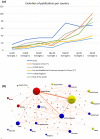The sharing of research data facing the COVID-19 pandemic
- PMID: 33935332
- PMCID: PMC8072296
- DOI: 10.1007/s11192-021-03971-6
The sharing of research data facing the COVID-19 pandemic
Abstract
During the previous Ebola and Zika outbreaks, researchers shared their data, allowing many published epidemiological studies to be produced only from open research data, to speed up investigations and control of these infections. This study aims to evaluate the dissemination of the COVID-19 research data underlying scientific publications. Analysis of COVID-19 publications from December 1, 2019, to April 30, 2020, was conducted through the PubMed Central repository to evaluate the research data available through its publication as supplementary material or deposited in repositories. The PubMed Central search generated 5,905 records, of which 804 papers included complementary research data, especially as supplementary material (77.4%). The most productive journals were The New England Journal of Medicine, The Lancet and The Lancet Infectious Diseases, the most frequent keyword was pneumonia, and the most used repositories were GitHub and GenBank. An expected growth in the number of published articles following the course of the pandemics is confirmed in this work, while the underlying research data are only 13.6%. It can be deduced that data sharing is not a common practice, even in health emergencies, such as the present one. High-impact generalist journals have accounted for a large share of global publishing. The topics most often covered are related to epidemiological and public health concepts, genetics, virology and respiratory diseases, such as pneumonia. However, it is essential to interpret these data with caution following the evolution of publications and their funding in the coming months.
Keywords: COVID-19; Data sharing; PubMed central; Repository; Supplementary material.
© Akadémiai Kiadó, Budapest, Hungary 2021.
Conflict of interest statement
Conflict of interestThe authors report no conflicts of interest.
Figures





References
-
- Aleixandre-Benavent R, Castelló-Cogollos L, Valderrama-Zurián J-C. Information and communication during the early months of Covid-19. Infodemics, misinformation and the role of information professionals. El profesional de la información. 2020 doi: 10.3145/epi.2020.jul.08. - DOI
-
- Calling all coronavirus researchers: keep sharing, stay open. (2020). Nature, 578(7793), 7. https://doi.org/10.1038/d41586-020-00307-x. - PubMed
LinkOut - more resources
Full Text Sources
Other Literature Sources
Miscellaneous
